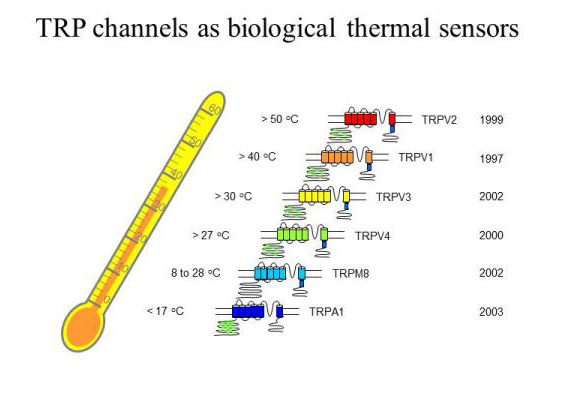This computer model shows how capsaicin binds with the TRPV1 receptor, causing conformational changes that lead to the sensation of pain and heat. [Courtesy of J. Zheng lab, UC Davis]

Spicy foods—some can’t get enough of the delicious masochistic pain while others will steer well clear of what they view as a sadistic punishment of the senses. What is true for both groups, however, is the underlying molecular mechanisms of how the body reacts to spicy compounds and interprets the outcome as pain.
Scientists at the University of California, Davis are now taking advantage of that commonality and have identified the molecular interactions that allow capsaicin—the molecule in chili peppers that makes them hot and spicy—to activate the body's primary receptor for sensing heat and pain, with the ultimate intent to develop more selective and effective drugs to relieve pain.
“While we have known that capsaicin binds to the TRPV1 receptor with exquisite potency and selectivity, we were missing important atomic-level details about exactly how the capsaicin molecule interacts with TRPV1, one of the body's primary receptors for sensing pain and heat,” explained Jie Zheng, Ph.D., professor of physiology and membrane biology at UC Davis and senior author on the current study.
The findings from this study were published recently in Nature Chemical Biology through an article entitled “Structural mechanism underlying capsaicin binding and activation of the TRPV1 ion channel.”
The researchers took advantage of some existing low-resolution 3D reconstructions of the TRPV1-capsaicin complex and combined it with computer models they generated based on atomic force fields. From these combined models, they were able to identify several structural areas where capsaicin was able to bind very strongly to the TRPV1 receptor.
“Computational biology methods are becoming very powerful tools for predicting and ultimately validating the high-resolution structure of important biological proteins and ligands, such as capsaicin and TRPV1, when they interact,” said Vladimir Yarov-Yarovoy, Ph.D., assistant professor of physiology and membrane biology at UC Davis and co-author on the study. “These tools are especially useful when the interactions are small and transient, and cannot be captured easily with high-enough resolution using traditional experimental approaches.”
Some of the original structures of the TRPV1 channel had been resolved with capsaicin bound to the channel, however the resolution was not of high enough quality to determine the chemical structure nor the specific ligand-channel interactions, which are extremely important details for a thorough mechanistic understanding. This is the reason Dr. Zheng’s team took a computational approach to resolving the structural interactions.
“The electron density observed in the cryo-electron microscopy structure of the TRPV1-capsaicin complex is much smaller in size compared to the chemical structure of capsaicin,” stated Fan Yang, Ph.D., postdoctoral fellow in Dr. Zheng’s laboratory and lead author on the study. “With computational docking, we were able to detail the atomic interactions between capsaicin and the TRPV1 channel and later validate the molecular architecture using other experimental approaches.”
Dr. Zheng and his colleagues are excited about the detailed model that they generated and are hopeful that the new structural information will serve as a blueprint towards rational drug design of improved pain medications.
“Just as we can 'get used to' a spicy dish by the end of the meal, we believe that there are ways to develop highly specific molecules that make TRPV1 less sensitive to painful stimuli,” Dr. Zheng concluded.



